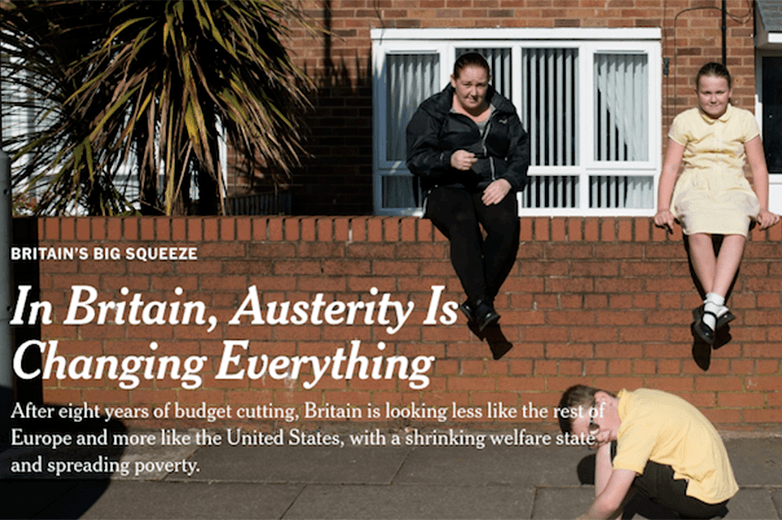It’s safe to say the New York Times doesn’t take a particularly fond view of Britain these days. Whether it’s their ongoing Brexit coverage, mistaking a newspaper sketch writer’s joke about the French for Brexit bias or attempting to cash in with a $6,000 Brexit tour of… London, the American paper’s gloomy editorial team tend to see the glass as empty – let alone half empty.
So, Mr S was curious to read the latest NYT take on Blighty. On the paper’s front page lies an article titled ‘In Britain, austerity is changing everything’. The author – Peter S Goodman – alleges that the UK is turning away from its European neighbours and starting to resemble America when it comes to ‘shrinking welfare’ and ‘spreading poverty’:
‘After eight years of budget cutting, Britain is looking less like the rest of Europe and more like the United States, with a shrinking welfare state and spreading poverty.’
The evidence? Well, it begins with Prescot – where it seems most public services are being scrapped, as per the intro:
‘PRESCOT, England — A walk through this modest town in the northwest of England amounts to a tour of the casualties of Britain’s age of austerity.
The old library building has been sold and refashioned into a glass-fronted luxury home. The leisure center has been razed, eliminating the public swimming pool. The local museum has receded into town history. The police station has been shuttered.’
Only, as the IEA’s Christopher Snowdon points out, it’s not clear that Prescot is the deserted ghost town that the author makes out:
1. A new fire and police station was opened this year
Goodman says that the police station has been shuttered. Was he looking in the right place? In January this year, a new Prescot Police and Fire station was opened:

2. There is a Prescot library
The author notes that the ‘old library building has been sold and refashioned into a glass-fronted luxury home’. What they don’t bother to mention is that there is a functioning Prescot library – at least as of May 26th:
Really want to give up smoking? Free help is available here at Prescot Library every Tuesday morning! pic.twitter.com/aGCuym2Smj
— Knowsley Libraries (@Knowsleylib) May 26, 2018
3. There is a Prescot museum
The author says that the ‘local museum has receded into town history’. Perhaps he could have tried the Prescot Museum for size?
Even the author appears to refrain from suggesting his article is based on objective facts:
Note that this is a consolidation. Moreover, people in the village feel a loss. If you want to argue with them, that’s fine, but it’s a widespread perception in Prescot
— Peter S. Goodman (@petersgoodman) May 28, 2018
What ever will the next instalment bring?

























